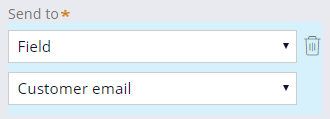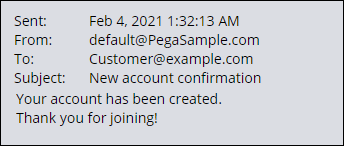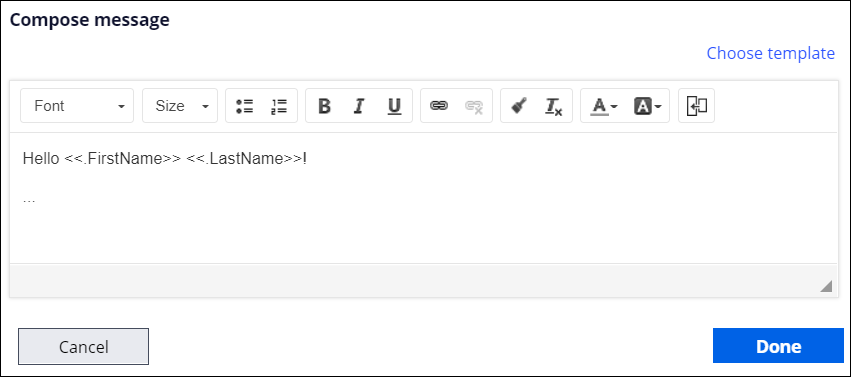
Email correspondence
Organizations depend on timely communication to establish a shared understanding of transactions or assignments. In Pega Platform™, the system can send automated email correspondence to all relevant parties. For example, consider a requirement for an automobile claims application. The application sends an email to customers when their claims are successfully filed, and any time the status of the claim changes.
To achieve effective communication, answer three simple questions:
- With whom do I need to communicate?
- How will the communication be composed?
- When does the communication need to be sent?
Identify users with whom to communicate
When configuring correspondence, first determine, With whom do I need to communicate? One option is to send correspondence to a specific email address. This option depends on a consistent email address. Any time the email address changes, you must update the application or the correspondence will not be received by the appropriate person.
To avoid recurring changes to an email address, you can use fields, user references, and participants to send email correspondence.
Fields
You can send an email based on the value of a field.
For example, a new customer signs up for an account. The customer enters an email address in the Customer email field. When the customer submits information, Pega Platform uses the value entered in the field by the customer to send a confirmation email.
User references
In cases where the correspondence needs to be sent to one specific user in your application, you can use a user reference. The relevant user reference fields are defined in the case type and the associated data types. You can define a user reference field in the case type data model. For example, the head of the IT department receives status changes for high-priority issues. A user reference field called IT Manager is defined in the data model and used to send email correspondence to the appropriate user.
Two user reference fields, Create Operator and Update Operator, are automatically defined in the data model for each data type associated with the case type. For example, in an application with Request, Results, and Terms of use data types, each data type is listed with its respective Create Operator and Update Operator.
Participants
Pega Platform can also use participant information to send correspondence to a group of stakeholders. Case participants are people, businesses, and organizations that are involved in a case. By managing case participants, you can define their relationship with a case and share important case updates with them. Pega Platform identifies the recipient's email address from the participant information. An email is sent to any user associated with the selected participant. For example, your company grants car loans to the employees of an organization. To send loan updates to key members of the organization, you can add these members as participants in Car Loan cases.
Note: Manage participants from the case type Settings tab.
In Pega Platform, you can use the following default participants for correspondence:
| Participant | Description |
|---|---|
| Owner | The person who created the case. |
| Customer | The person on whose behalf the case is transacted. This person may not process the case but may want — or need — notification of any changes. |
| Interested | A person who tracks the progress of a case but does not process the case. |
Note: In addition to selecting one of the participants, you can also choose to send email correspondence to all participants.
Check your knowledge with the following interaction:
Identify how to compose the correspondence
After determining who receives the communication, ask yourself, How will the communication be composed? Pega Platform provides a rich text editor to create formatted email correspondence. The editor allows you to reuse data from the case in the email. For example, you can enter a greeting with the customer's first and last name by referencing the fields that capture this information in the case.
You can also use existing correspondence templates. Pega Platform provides out-of-the-box templates that use case processing data, such as the case ID (.pyID) and case status (.pyStatusWork).
Identify when to communicate with users
The last question you need to answer is When does the communication need to be sent?
Send email automation
Pega Platform simplifies sending correspondence by allowing you to add a Send email automation to your case to send an email. When a case reaches the Send email step, the email is automatically sent to the selected parties. For example, in a Place order process, users select order items, the shipping address, and the payment method. Once users confirm the order, the case automatically sends users a confirmation email.
Case-level notifications
Another option is to configure email notifications at the case level. At the case level, you can automatically send a notification when an assignment in the case is routed to a worklist. Case-level notifications automatically send notifications to the user who is associated with the worklist. Configure case-level notifications on the Settings tab for the case type of interest. In the Notifications section, select the Email user when the assignment is routed to worklist checkbox, as shown in the following figure:
Because the configuration for the email notification occurs at the case level, you compose a relevant email for all the users who receive the notification during case processing. If the message is left blank, the system uses the following default message:
.pyLabel + "(" + .pyID + ") moved to your worklist"
For example, in an Onboarding case type for new employees, an HR member receives the following default message:
Onboarding (O-2183) moved to your worklist
Note: The system only sends notifications once the case enters the routed assignments.
Check your knowledge with the following interaction:
This Topic is available in the following Module:
If you are having problems with your training, please review the Pega Academy Support FAQs.
Want to help us improve this content?







